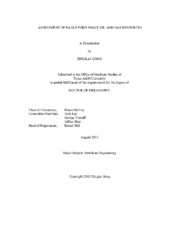| dc.contributor.advisor | McVay, Duane Allen | |
| dc.creator | Gong, Xinglai | |
| dc.date.accessioned | 2013-12-16T20:13:47Z | |
| dc.date.available | 2013-12-16T20:13:47Z | |
| dc.date.created | 2013-08 | |
| dc.date.issued | 2013-07-30 | |
| dc.date.submitted | August 2013 | |
| dc.identifier.uri | https://hdl.handle.net/1969.1/151324 | |
| dc.description.abstract | The Eagle Ford play in south Texas is currently one of the hottest plays in the United States. In 2012, the average Eagle Ford rig count (269 rigs) was 15% of the total US rig count. Assessment of the oil and gas resources and their associated uncertainties in the early stages is critical for optimal development. The objectives of my research were to develop a probabilistic methodology that can reliably quantify the reserves and resources uncertainties in unconventional oil and gas plays, and to assess Eagle Ford shale oil and gas reserves, contingent resources, and prospective resources.
I first developed a Bayesian methodology to generate probabilistic decline curves using Markov Chain Monte Carlo (MCMC) that can quantify the reserves and resources uncertainties in unconventional oil and gas plays. I then divided the Eagle Ford play from the Sligo Shelf Margin to the San Macros Arch into 8 different production regions based on fluid type, performance and geology. I used a combination of the Duong model switching to the Arps model with b = 0.3 at the minimum decline rate to model the linear flow to boundary-dominated flow behavior often observed in shale plays. Cumulative production after 20 years predicted from Monte Carlo simulation combined with reservoir simulation was used as prior information in the Bayesian decline-curve methodology. Probabilistic type decline curves for oil and gas were then generated for all production regions. The wells were aggregated probabilistically within each production region and arithmetically between production regions. The total oil reserves and resources range from a P_(90) of 5.3 to P_(10) of 28.7 billion barrels of oil (BBO), with a P_(50) of 11.7 BBO; the total gas reserves and resources range from a P_(90) of 53.4 to P_(10) of 313.5 trillion cubic feet (TCF), with a P_(50) of 121.7 TCF. These reserves and resources estimates are much higher than the U.S. Energy Information Administration’s 2011 recoverable resource estimates of 3.35 BBO and 21 TCF. The results of this study provide a critical update on the reserves and resources estimates and their associated uncertainties for the Eagle Ford shale formation of South Texas. | en |
| dc.format.mimetype | application/pdf | |
| dc.language.iso | en | |
| dc.subject | Probabilistic Decline Curve | en |
| dc.subject | Analysis | en |
| dc.subject | Eagle Ford | en |
| dc.subject | Shale Oil | en |
| dc.subject | Shale Gas | en |
| dc.subject | Reserves | en |
| dc.subject | Resources | en |
| dc.subject | Bayesian | en |
| dc.subject | MCMC | en |
| dc.title | Assessment of Eagle Ford Shale Oil and Gas Resources | en |
| dc.type | Thesis | en |
| thesis.degree.department | Petroleum Engineering | en |
| thesis.degree.discipline | Petroleum Engineering | en |
| thesis.degree.grantor | Texas A & M University | en |
| thesis.degree.name | Doctor of Philosophy | en |
| thesis.degree.level | Doctoral | en |
| dc.contributor.committeeMember | Lee, William John | |
| dc.contributor.committeeMember | Voneiff, George | |
| dc.contributor.committeeMember | Hart, Jeffrey | |
| dc.type.material | text | en |
| dc.date.updated | 2013-12-16T20:13:47Z | |


